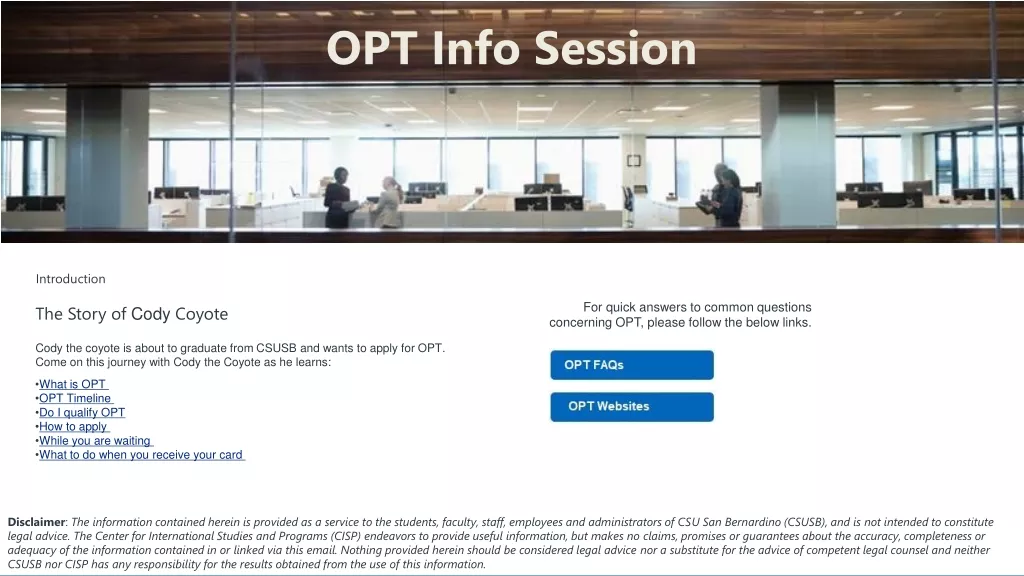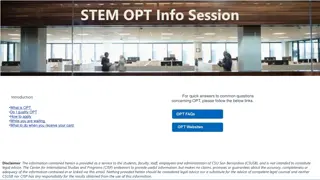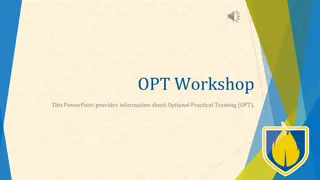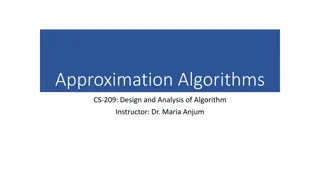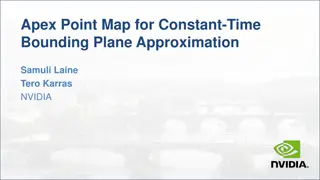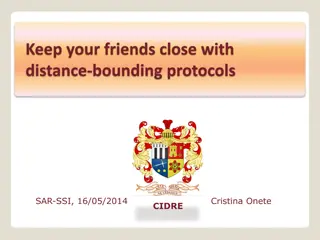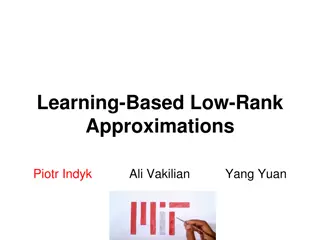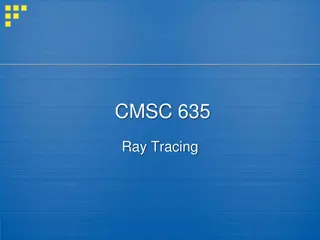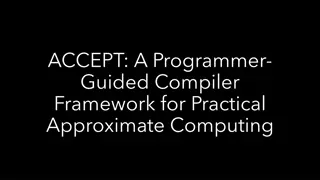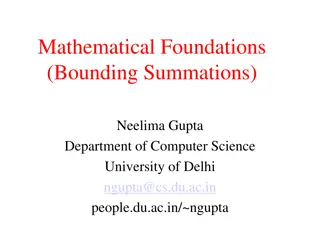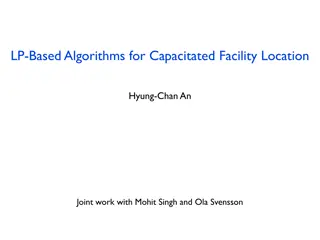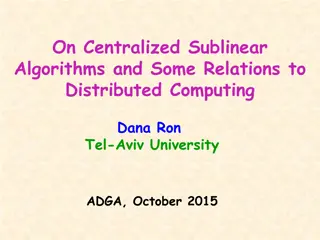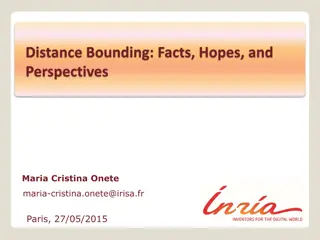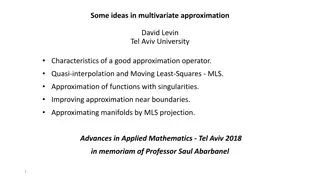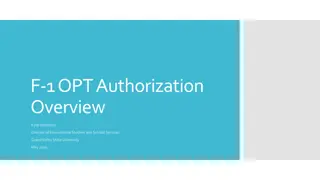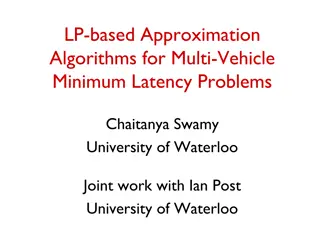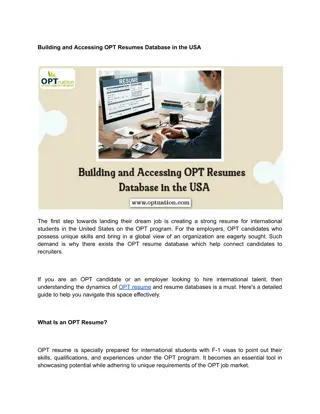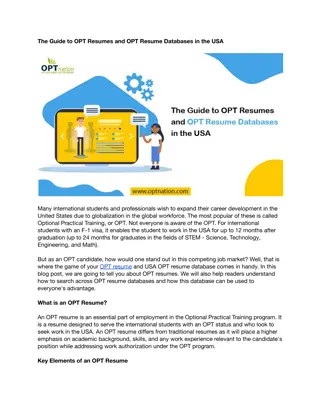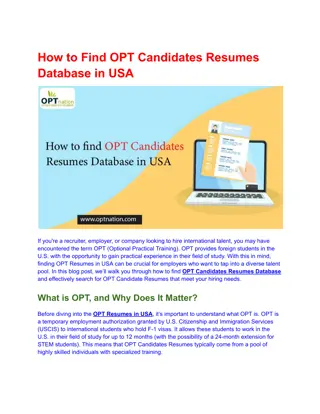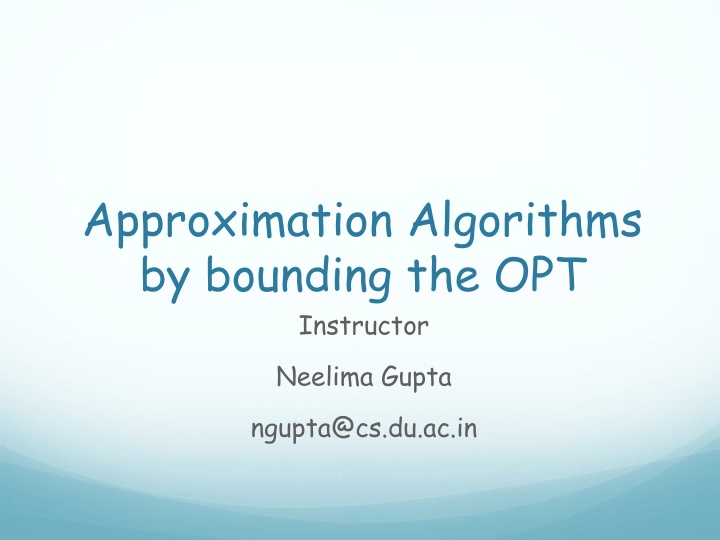
Understanding Approximation Algorithms by Bounding the Optimum
Dive into the world of approximation algorithms and learn how to find solutions close to the optimum for NP-Complete problems using bounding techniques. Explore factor-2 algorithms, lower bounding the OPT, and potential improvements in approximation guarantees.
Uploaded on | 0 Views
Download Presentation

Please find below an Image/Link to download the presentation.
The content on the website is provided AS IS for your information and personal use only. It may not be sold, licensed, or shared on other websites without obtaining consent from the author. If you encounter any issues during the download, it is possible that the publisher has removed the file from their server.
You are allowed to download the files provided on this website for personal or commercial use, subject to the condition that they are used lawfully. All files are the property of their respective owners.
The content on the website is provided AS IS for your information and personal use only. It may not be sold, licensed, or shared on other websites without obtaining consent from the author.
E N D
Presentation Transcript
Approximation Algorithms by bounding the OPT Instructor Neelima Gupta ngupta@cs.du.ac.in
Approximation Algorithms Approximate algorithms give approximate solution to NP-Complete problems which is close to optimum solution. Maximization problems E.g. Clique Optimum clique > Approx. clique >= *( Optimum clique) Minimization problems E.g. Vertex Cover Minimum vc < Approx. vc < = 2*(Minimum vc)
Factor-2 algorithm Find a maximal matching in the graph and output the matched vertices. Let S be this set of vertices. Claim 1: S forms a vertex cover. Proof: Suppose not. Then there exists an edge e = (u,v) such that neither u nor v is in S. This implies that the matching could have been extended by this edge e and hence was not maximal --- a contradiction. Claim 2: |S| <= 2 OPT Proof: We ll prove this by giving some lower bound say LB for OPT and showing that |S| <= 2 LB Standard Technique
Lower bounding the OPT Claim: OPT >= size of any (maximal) matching Proof: Let M be a (maximal) matching. For every e = (u,v ) in M, any vertex cover must pick at least one of u and v. Hence size of any vertex cover >= |M|. Hence, in particular, OPT > = |M| Clearly |S| = 2* |maximal matching| Hence Claim2 follows.
Can the approximation guarantee be improved? Following Qs need to be addresses Can the approximation guarantee be improved by a better analysis? Can an approximation algorithm with a better guarantee be designed bounding scheme of maximal matching? Is there some other lower bounding technique that can give an improved guarantee for vertex cover? using the lower
Tight Example What is the meaning of Q1? Can we get a solution S using the above algorithm such that |S| < 2* OPT (for every instance of the problem)? Say |S| = 3/2 * OPT? Answer to the Q is No. Here is an example of an instance on which the above algorithm will always give a solution whose cost = 2*OPT. Complete Bipartite Graph: Kn,n: OPT = n, |S| = 2n.
Q2 i.e. Can we design an algorithm that gives a vertex cover solution S such that |S| < 2* |maximal matching| (for every instance of the problem)? Say |S| <= 3/2* |maximal matching|? Ans: No. Here is an example of an instance where the size of any vertex cover is at least 2 * |maximal matching|. Example: Kn: Complete graph of size n, n odd. |Size of maximal matching| is (n-1)/2 and OPT = n-1. Thus the size of any vertex cover >= OPT = n 1 = 2 * |maximal matching|.
Q3 Still an Open Problem!!!
Metric Travelling Salesman Problem Problem Statement Given A complete graph G with non-negative edge costs that satisfy triangle inequality To Find exactly once. A minimum cost cycle visiting every vertex
Metric TSP - factor 2 approx. algorithm 1. 2. Find an Minimum Spanning Tree (MST) T of G. Double every edge of the MST to obtain an Eulerian graph. 3. 4. Find a Eulerian tour, T , on G. Output the tour that visits vertices of G in the order of their first appearance in T . Call this tour C. (Short Cutting)
Example Given a Complete Graph 3 3 V8 V2 V1 3 5 1 7 3 2 V4 V7 V3 2 V10 2 1 6 5 V5 V9 2 V6 4 Edges shown dotted do not carry weight and are assumed to be shortest path between the pair of vertices( due to triangular inequality).
Step1: Compute Minimum Spanning Tree 3 3 V1 V2 V8 3 1 5 7 3 2 V7 V4 V3 2 V10 6 2 5 V5 1 V6 V9 2 4
Step 2: Double each edge of MST 3 3 V2 V8 3 V1 1 3 1 3 2 V7 V4 V3 2 3 2 2 2 V10 2 V5 1 V9 V6 2 1 2
Step 3: Computing Eulerian Cycle A cycle is one in which each edge visited exactly once 3 3 V2 V8 V1 3 1 3 3 1 3 2 V7 V4 2 V3 2 2 2 2 V10 1 V5 1 V6 V9 2 2 v1 v10 v2 v9 v3 v7 v4 v8 v5 v7 v3 v6 v2 v5 v1 v4 v3 v7 v9
Step 4: Computing solution for TSP 3 3 V8 V1 V2 3 3 1 1 3 3 2 V4 V7 V3 2 2 2 V10 2 1 2 V5 V6 V9 2 1 2 v1 v2 v3 v4 v5 v6 v5 v4 v3 v7 v9 v10 v9 v7 v8 v7 v3 v2 v1
Approximate solution for TSP 3 V8 V1 V2 1 3 V3 V7 V4 2 V10 2 V5 1 V6 2 V9 v1 v2 v3 v4 v5 v6 v7 v9 v10 v8 v1
Metric TSP - factor 2 approx. algorithm We now show that the proposed algorithm is indeed a factor 2 approximation algorithm for metric TSP Observe that: Removing any edge from an optimal solution to TSP would give a spanning tree of the graph. So the cost of an MST in the graph can be used as lower bound for obtaining factor 2 for this algorithm
Metric TSP - factor 2 approx. algorithm Therefore, cost(T) <= OPT T contains each edge of T twice, so cost(T ) = 2*cost(T) Also, cost(C) <= cost(T ) because of triangle inequality Hence cost(C) <= 2*OPT
FACTOR 3/2 APPROXIMATION ALGORITHM FOR TSP
Metric TSP improving the factor to 3/2 Observations: Consider why did we have to double the MST to obtain an Euler tour. Can we have an Euler tour with lower cost? YES ! A graph has an Euler tour if and only if all its vertices have even degrees. We therefore need to be bothered about the vertices of odd degree only.
Metric TSP - improving the factor to 3/2 Let V be the set of vertices of odd degree Cardinality of V must be even. WHY? Because the sum of degrees of all vertices in MST has to be even. Add to the MST, a minimum cost perfect matching on V so that every vertex has an even degree. We also know that a polynomial time algorithm exists for finding the minimum cost perfect matching.
Metric TSP - factor 3/2 approx. algorithm Step 1: Find an MST, T, of G. Step 2: Compute a minimum cost perfect matching, M, on the odd degree vertices of T. Add M to T and obtain an Eulerian graph. Step 3: Find an Euler tour, T , of this graph. Step 4: Output the tour that visits vertices of G in order of their first appearance in T . Call this tour C.
Step1: Compute Minimum Spanning Tree 3 3 V1 V2 V8 3 1 5 7 3 2 V7 V4 V3 2 V10 6 2 5 V5 1 V6 V9 2 4
Step2: Compute Minimum Cost Perfect Matching 3 V1 V2 V8 3 1 3 2 V7 V4 V3 2 V10 2 V5 1 V6 V9 2 V1, V3, V6, V7, V8, V10 are odd degree vertices
Step 3: Computing Eulerian Cycle A cycle is one in which each edge visited exactly once V1 V2 V8 V7 V4 V3 V10 V5 V6 V9 Eulerian Cycle : V1 V8 V2 V1 V3 V4 V5 V6 V3 V7 V9 V10 V7
Step 4: Computing solution for TSP V1 V2 V8 V7 V4 V3 V10 V5 V6 V9 Solution for TSP : V1 V2 V10 V8 V3 V1 V4 V5 V6 V7 V9
Approximate solution for TSP V1 V2 V8 V7 V4 V3 V10 V5 V6 V9 Solution for TSP : V1 V2 V8 V1 V3 V4 V5 V6 V7 V9 V10
Metric TSP - factor 3/2 approx. algorithm In order to show that the proposed algorithm is a factor 3/2 approximation algorithm for metric TSP, we first need to understand the following: Given a subset V of V with even number of elements, and a minimum cost perfect matching M on V , cost(M) <= OPT/2 Let us try to prove the above result !
Metric TSP - factor 3/2 approx. algorithm Consider an optimal TSP tour of G, say t. Let t be the tour on V obtained by shortcutting t. Clearly, cost(t )<=cost(t) because of triangle inequality. Now t is the union of two perfect matchings on V each consisting of alternate edges of t. Therefore, the cheaper of these matchings has cost <= cost(t )/2<=OPT/2. Hence the optimal matching also has cost at most OPT/2.
Metric TSP - factor 3/2 approx. algorithm In view of this result, let us now see if the proposed algorithm ensures an approximation guarantee of 3/2 for metric TSP Problem Cost of the Euler tour, T t cos ) ' ( cos + / 1 + / 3 = T ( ) cos ( ) OPT 2 OPT 2 t t M OPT Using triangle inequality, cost(C)<=cost(T ). Hence Proved!
Acknowledgements Swati Singhal Varun Mendiratta Sumedha Upadhyaya Prachi Nagpal

